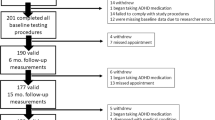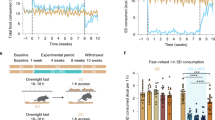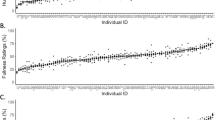Abstract
Background and objectives
The relative reinforcing value (RRV) of food is associated with increased energy intake and obesity and increases in RRV of food after repeated intake (sensitization) are related cross-sectionally and prospectively to higher BMI in adults. We examined the factors, such as delay discounting (DD), associated with sensitization of RRV to high energy density (HED) and low energy density (LED) food and how sensitization relates to zBMI in adolescents. We hypothesized that sensitization to HED food would be positively associated with zBMI, that sensitization to LED food would be negatively associated with zBMI, that DD would be associated with HED sensitization, and that LED sensitization and DD would moderate the relationships between HED sensitization and zBMI.
Subjects and methods
A population-based sample of 207 adolescents without obesity, aged 12–14 years was studied from June 2016–March 2019. The RRV of LED and HED foods were measured before and after two weeks of daily consumption along with zBMI and other potential factors related to eating and weight, including dietary restraint, hunger, food liking, and delay discounting (DD). Hierarchical regression models were used to determine the associations between these factors and sensitization and zBMI. We also examined LED sensitization and DD as potential moderators of the relationship between sensitization and zBMI.
Results
As hypothesized, dietary restraint and sensitization to HED food were associated with greater zBMI. Contrary to our original hypotheses, DD was not associated with sensitization, there was no relationship between sensitization to LED food and zBMI and neither LED sensitization or DD moderated the relationship between HED sensitization and zBMI.
Conclusions
Sensitization to repeated intake of HED food was associated with higher zBMI in adolescents without obesity. Sensitization may be a novel behavioral phenotype that may relate to overweight in youth.
This is a preview of subscription content, access via your institution
Access options
Subscribe to this journal
Receive 12 print issues and online access
$259.00 per year
only $21.58 per issue
Buy this article
- Purchase on Springer Link
- Instant access to full article PDF
Prices may be subject to local taxes which are calculated during checkout


Similar content being viewed by others
References
Epstein LH, Lin H, Carr KA, Fletcher KD. Food reinforcement and obesity. Psychological moderators. Appetite. 2012;58:157–62.
Epstein LH, Yokum S, Feda DM, Stice E. Food reinforcement and parental obesity predict future weight gain in non-obese adolescents. Appetite. 2014;82:138–42.
Temple JL. Factors that influence the reinforcing value of foods and beverages. Physiol Behav. 2014;136:97–103.
Epstein LH, Leddy JJ, Temple JL, Faith MS. Food reinforcement and eating: a multilevel analysis. Psychol Bull. 2007;133:884–906.
Temple JL, Legierski CM, Giacomelli AM, Salvy SJ, Epstein LH. Overweight children find food more reinforcing and consume more energy than do nonoverweight children. Am J Clin Nutr. 2008;87:1121–7.
Clark EN, Dewey AM, Temple JL. Effects of daily snack food intake on food reinforcement depend on body mass index and energy density. Am J Clin Nutr. 2010;91:300–8.
Temple JL. Behavioral sensitization of the reinforcing value of food: What food and drugs have in common. Prev Med. 2016;92:90–9.
Temple JL, Bulkley AM, Badawy RL, Krause N, McCann S, Epstein LH. Differential effects of daily snack food intake on the reinforcing value of food in obese and nonobese women. Am J Clin Nutr. 2009;90:304–13.
Temple JL, Chappel A, Shalik J, Volcy S, Epstein LH. Daily consumption of individual snack foods decreases their reinforcing value. Eating Behav. 2008;9:267–76.
Berridge KC, Robinson TE. Liking, wanting, and the incentive-sensitization theory of addiction. Am Psychol. 2016;71:670–9.
Robinson TE, Berridge KC. The neural basis of drug craving: an incentive-sensitization theory of addiction. Brain Res Brain Res Rev. 1993;18:247–91.
Robinson TE, Berridge KC. The psychology and neurobiology of addiction: an incentive-sensitization view. Addiction. 2000;95(Suppl 2):S91–117.
Robinson TE, Berridge KC. Review. The incentive sensitization theory of addiction: some current issues. Philos Trans R Soc Lond B Biol Sci. 2008;363:3137–46.
Temple JL, Epstein LH. Sensitization of food reinforcement is related to weight status and baseline food reinforcement. Int J Obes. 2012;36:1102–7.
Appelhans BM, Waring ME, Schneider KL, Pagoto SL, DeBiasse MA, Whited MC, et al. Delay discounting and intake of ready-to-eat and away-from-home foods in overweight and obese women. Appetite. 2012;59:576–84.
Appelhans BM, Woolf K, Pagoto SL, Schneider KL, Whited MC, Liebman R. Inhibiting food reward: delay discounting, food reward sensitivity, and palatable food intake in overweight and obese women. Obesity. 2011;19:2175–82.
Fields SA, Sabet M, Peal A, Reynolds B. Relationship between weight status and delay discounting in a sample of adolescent cigarette smokers. Behav Pharmacol. 2011;22:266–8.
Rasmussen EB, Lawyer SR, Reilly W. Percent body fat is related to delay and probability discounting for food in humans. Behav Process. 2010;83:23–30.
Weller RE, Cook EW 3rd, Avsar KB, Cox JE. Obese women show greater delay discounting than healthy-weight women. Appetite. 2008;51:563–9.
Best JR, Theim KR, Gredysa DM, Stein RI, Welch RR, Saelens BE, et al. Behavioral economic predictors of overweight children’s weight loss. J Consult Clin Psychol. 2012;80:1086–96.
Stojek MMK, MacKillop J. Relative reinforcing value of food and delayed reward discounting in obesity and disordered eating: a systematic review. Clin Psychol Rev. 2017;55:1–11.
Carr KA, Daniel TO, Lin H, Epstein LH. Reinforcement pathology and obesity. Current Drug Abuse Rev. 2011;4:190–6.
Konrad K, Firk C, Uhlhaas PJ. Brain development during adolescence: neuroscientific insights into this developmental period. Dtsch Arztebl Int. 2013;110:425–31.
Moreno-Lopez L, Soriano-Mas C, Delgado-Rico E, Rio-Valle JS, Verdejo-Garcia A. Brain structural correlates of reward sensitivity and impulsivity in adolescents with normal and excess weight. PLoS One. 2012;7:e49185.
Vara AS, Pang EW, Vidal J, Anagnostou E, Taylor MJ. Neural mechanisms of inhibitory control continue to mature in adolescence. Dev Cogn Neurosci. 2014;10C:129–39.
Koebnick C, Coleman KJ, Black MH, Smith N, Der-Sarkissian JK, Jacobsen SJ, et al. Cohort profile: the KPSC Children’s Health Study, a population-based study of 920 000 children and adolescents in southern California. Int J Epidemiol. 2012;41:627–33.
Shields M, Tremblay MS. Canadian childhood obesity estimates based on WHO, IOTF and CDC cut-points. Int J Pediatr Obes. 2010;5:265–73.
Hill AJ, Pallin V. Dieting awareness and low self-worth: related issues in 8-year-old girls. Int J Eat Disord. 1998;24:405–13.
van Strien T, Herman CP, Verheijden MW. Dietary restraint and body mass change. A 3-year follow up study in a representative Dutch sample. Appetite. 2014;76:44–9.
Epstein LH, Kilanowski CK, Consalvi AR, Paluch RA. Reinforcing value of physical activity as a determinant of child activity level. Health Psychol. 1999;18:599–603.
Epstein LH, Temple JL, Neaderhiser BJ, Salis RJ, Erbe RW, Leddy JJ. Food reinforcement, the dopamine D2 receptor genotype, and energy intake in obese and nonobese humans. Behav Neurosci. 2007;121:877–86.
Temple JL, Bulkley AM, Briatico L, Dewey AM. Sex differences in reinforcing value of caffeinated beverages in adolescents. Behav Pharmacol. 2009;20:731–41.
Rollins BY, Dearing KK, Epstein LH. Delay discounting moderates the effect of food reinforcement on energy intake among non-obese women. Appetite. 2010;55:420–5.
Johnson MW, Bickel WK. An algorithm for identifying nonsystematic delay-discounting data. Exp Clin Psychopharmacol. 2008;16:264–74.
Anokhin AP, Golosheykin S, Mulligan RC. Long-term test-retest reliability of delayed reward discounting in adolescents. Behav Process. 2015;111:55–9.
Isen JD, Sparks JC, Iacono WG. Predictive validity of delay discounting behavior in adolescence: a longitudinal twin study. Exp Clin Psychopharmacol. 2014;22:434–43.
Himes JH, Dietz WH. Guidelines for overweight in adolescent preventive services: recommendations from an expert committee. The Expert Committee on Clinical Guidelines for Overweight in Adolescent Preventive Services. Am J Clin Nutr. 1994;59:307–16.
Stubbs RJ, Hughes DA, Johnstone AM, Rowley E, Reid C, Elia M, et al. The use of visual analogue scales to assess motivation to eat in human subjects: a review of their reliability and validity with an evaluation of new hand-held computerized systems for temporal tracking of appetite ratings. Br J Nutr. 2000;84:405–15.
Hayes AF, Cai L. Using heteroskedasticity-consistent standard error estimators in OLS regression: an introduction and software implementation. Behav Res Methods. 2007;39:709–22.
Epstein LH, Carr KA, Lin H, Fletcher KD. Food reinforcement, energy intake, and macronutrient choice. Am J Clin Nutr. 2011;94:12–8.
Steele CC, Pirkle JRA, Davis IR, Kirkpatrick K. Dietary effects on the determinants of food choice: Impulsive choice, discrimination, incentive motivation, preference, and liking in male rats. Appetite. 2019;136:160–72.
Westwater ML, Fletcher PC, Ziauddeen H. Sugar addiction: the state of the science. Eur J Nutr. 2016;55(Suppl 2):55–69.
Carr KA, Epstein LH. Influence of sedentary, social, and physical alternatives on food reinforcement. Health Psychol. 2018;37:125–31.
Acknowledgements
This study was funded by NIH R01 DK106265 (JLT). We thank Lori Hazinger, Aaron Anderson, Meredith Edelman, and Alessia Galante for their years of help in collecting these data.
Author information
Authors and Affiliations
Corresponding author
Ethics declarations
Conflict of interest
The authors declare that they have no conflict of interest.
Additional information
Publisher’s note Springer Nature remains neutral with regard to jurisdictional claims in published maps and institutional affiliations.
Rights and permissions
About this article
Cite this article
Temple, J.L., Ziegler, A.M., Crandall, A.K. et al. Sensitization of the reinforcing value of food: a novel risk factor for overweight in adolescents. Int J Obes 44, 1918–1927 (2020). https://doi.org/10.1038/s41366-020-0641-4
Received:
Revised:
Accepted:
Published:
Issue Date:
DOI: https://doi.org/10.1038/s41366-020-0641-4
This article is cited by
-
Having less and wanting more: an investigation of socioeconomic status and reinforcement pathology
BMC Public Health (2021)



